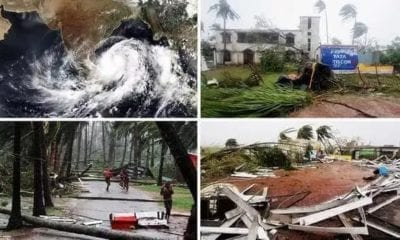Climate
Titbits of Tropical Cyclone

A tropical cyclone is a rapidly rotating storm system characterized by a low-pressure center, a closed low-level atmospheric circulation, strong winds, and a spiral arrangement of thunderstorms that produce heavy rain. Depending on its location and strength, a tropical cyclone is referred to by different names, including hurricane typhoon tropical storm, cyclonic storm, tropical depression, and simply cyclone. A hurricane is a tropical cyclone that occurs in the Atlantic Ocean and the northeastern Pacific Ocean, and a typhoon occurs in the northwestern Pacific Ocean; in the south Pacific or the Indian Ocean, comparable storms are referred to simply as “tropical cyclones” or “severe cyclonic storms”.
“Tropical” refers to the geographical origin of these systems, which form almost exclusively over tropical seas. “Cyclone” refers to their winds moving in a circle, whirling around their central clear eye, with their winds blowing counterclockwise in the Northern Hemisphere and clockwise in the Southern Hemisphere. The opposite direction of circulation is due to the Coriolis effect. Tropical cyclones typically form over large bodies of relatively warm water. They derive their energy through the evaporation of water from the ocean surface, which ultimately recondenses into clouds and rain when moist air rises and cools to saturation.
The strong rotating winds of a tropical cyclone are a result of the conservation of angular momentum imparted by the Earth’s rotation as air flows inward toward the axis of rotation. As a result, they rarely form within 5° of the equator.
Tropical cyclones are almost unknown in the South Atlantic due to consistently strong wind shear and a weak Intertropical Convergence Zone. Also, the African easterly jet and areas of atmospheric instability which give rise to cyclones in the Atlantic Ocean and the Caribbean Sea, along with the Asian monsoon and Western Pacific Warm Pool, are features of the Northern Hemisphere and Australia.
Why the east coast of India is more prone to cyclone rather than the west coast?
Causes:
The Indian subcontinent is one of the worst cyclone-affected areas in the world. Unfortunately, almost 80 percent of the cyclones hit the eastern coast only. The reasons for this difference in hit ratio can be the following:-
(a) Temperature:- BOB(Bay of Bengal) is hotter than the Arabian sea. Hot water temperature is the basic criteria for the development & intensification of cyclones.
(b) Salinity:- Arabian sea has higher salinity than BOB. Its easier to heat & simultaneously evaporate water having lower salinity.
(c) Location:- The typhoons originating in the Pacific ocean too influences the cyclones in BOB, not the case in the Arabian sea.
(d) Movement:- According to IMD cyclones originating in the Arabian sea are believed to move northwest. So they actually move away from the Indian mainland.
Other causes:
- Tropical easterly jet stream shifts its position wrt ITCZ(from east to west) and the tropical cyclones that get embedded in it flow towards the west that is the east coast.
- Warmer coromandel coast due to a comparatively high sea surface temperature of Bay of Bengal that provides an ideal factor of cyclone formation.
- The Bay of Bengal offers a lower vertical wind speed or wind shear which is ideal for a tropical cyclone to be formed.
- Typhoons of S.China sea provide the leftover moisture to Bay Of Bengal adding to favorable conditions.
- East coast, unlike west coast, has no strong mountain range like the Western Ghats to block the cyclonic winds.
Why tropical cyclones hit Odisha frequently?
Because the geographical location of Odisha puts it in the prime path of the retreating Northern East monsoon during October, when the rainy season ends. The northern coasts of Andhra Pradesh, entire Odisha, Eastern Bihar, Southern part of West Bengal most of the times come in the red alert zone when retreating monsoon passes through them. That’s because the Bay of Bengal which is warmer than the Arabian Sea often experiences depression concentrated in Sea due to low pressure.
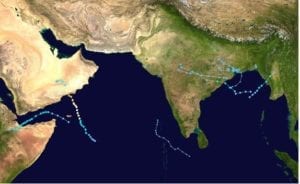
This is the cyclonic depressions of 2018.
That depression sometimes dissolves and causes heavy rain only. Otherwise, it turns into the severe cyclone and affects Odisha severely on a large scale.
See the path of these tropical cyclones over the years.
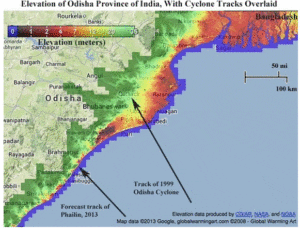
Pathway of Super cyclone 1999.
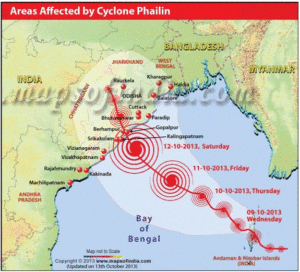
2013 cyclone Phailin pathway.
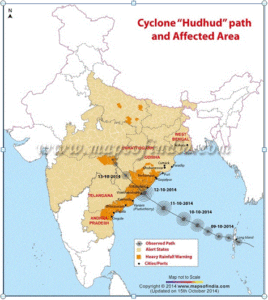
2014, Hudhud cyclone pathway.
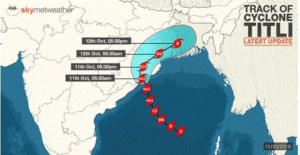
2018, Pathway of the cyclone Titli.
One can easily notice that Odisha is most of the time the first land to be struck by the emerged cyclone. Until it passes to other areas the effects are a little bit dissolved that that of Odisha. So sadly Odisha becomes the most vulnerable state to get affected by the cyclone.
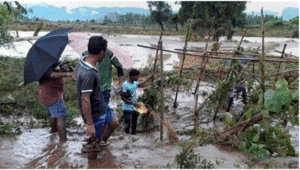
Why do paths of hurricanes, typhoons, and other tropical cyclones recurve?
Generally, tropical cyclones, known variously as a hurricane, typhoons, etc., start out moving west then turn toward the pole of their hemisphere and finally end up moving east. This pattern is called curvature. Here is the worldwide pattern.

From the above display, it is clear that curvature has something to do with the rotation of the Earth. Local wind and temperature conditions and local topography can influence the path and produce erratic elements to the paths but the general pattern has to have a geophysical explanation.
That explanation is that a cyclone has two components of angular momenta. One is with respect to its own spin axis and the other is with respect to the spin axis of the Earth. When a body with angular momenta, such as a gyroscope, is subjected to a torque it processes; i.e., it angular momentum vector rotates. If a body with angular momentum is forced to process then it is subject to a torque. A cyclone rotates with the Earth and its angular momentum vector is kept pointing vertically because of the rising of warm air in its eye (center). The resulting torque forces the cyclone toward the pole in its hemisphere. But as the cyclone moves toward the pole it gets closer to the spin axis of the Earth. The preservation of angular momentum then results in the cyclone moving faster with respect to the pole and hence starts moving east. Its path has thus recurved.
| History of cyclones in Odisha | |||
| SI.No. | Date/Year | Category of Cyclone | Landfall and loss |
| 1. | 7-12 October 1737 | Super Cyclone | Crossed West Bengal Coast over Sunderbans |
| 2. | 31 October 1831 | Very Severe Cyclonic Storm | Crossed Odisha Coast near Balasore, Loss of life-50,000 |
| 3. | 2-5 October 1864 | Very Severe Cyclonic Storm | Crossed West Bengal Coast near Contai |
| 4. | 1-2 November 1864 | Very Severe Cyclonic Storm | Crossed Andhra Pradesh near Machilipatnam |
| 5. | 22 September 1885 | Super Cyclone | Crossed Odisha Coast at False Point, Loss of life- 5000 |
| 6. | 14-16 October 1942 | Very Severe Cyclonic Storm | Crossed West Bengal Coast near Contai |
| 7. | 8-11 October 1967 | Very Severe Cyclonic Storm | Crossed Odisha Coast between Puri and Paradeep |
| 8. | 26-30 October 1971 | Very Severe Cyclonic Storm | Crossed Odisha Coast near Paradeep, Loss of life- 10,000 |
| 9. | 14-20 November 1977 | Super Cyclone | Crossed Andhra Coast near Nizampatnam |
| 10. | 4-11 May 1990 | Super Cyclone | Crossed Andhra Coast about 40 Km S-W of Machlipatnam |
| 11. | 5-6 November 1996 | Very Severe Cyclonic Storm | Crossed Andhra Coast near Kakinada |
| 12. | 25-31 October 1999 | Super Cyclone | Crossed Odisha Coast near Paradeep at noon of 29 October |
| 13
|
4 October 2013 – 14 October 2013 | Extremely Severe Cyclone Phailin | Crossed Odisha Coast near Gopalpur at around 2130 IST of 13 October |
| 14 | 8 October 2014 – 14 October 2014 | Extremely Severe Cyclonic Storm Hudhud | Crossed Vizag coast, Andhra Pradesh at noon on 12 October |
| 15 | 8 October 2018-11 October 2018 | Very Severe Cyclonic Storm, Titili | Between 4:30 a.m. and 5:30 a.m. IST on October 11 (23:00–00:00 UTC on October 10–11), Titli made landfall near Palasa, Andhra Pradesh |
What makes cyclone Fani special?
Timing and strength are two factors that make Cyclone Fani different from most other tropical cyclones in this time of the year. Cyclone Fani developed near the Equator and this allowed it to gather massive strength and moisture as it could travel a long distance over the sea.
Cyclone Fani, which has been classified as an extremely severe cyclone (ESC), is the 10th such cyclone to hit India in May in past 52 years. Data from the India Meteorological Department (IMD) show that the last time an extremely severe cyclone hit India in May was in 2004. The other years when such cyclones were witnessed in May are 1968, 1976, 1979, 1982, 1997, 1999 and 2001.
Generally, extremely severe cyclones hit India’s east coast in the post-monsoon season (October-December). IMD data on cyclones that hit India between 1965 and 2017 show that the country has weathered 39 extremely severe cyclones in these 52 years. Of these, nearly 60 percent (23) was between October and December.
The India Meteorological Department (IMD) classifies cyclones on the basis of the maximum sustained surface wind speed (MSW) they generate.
The Cyclones are classified as severe (MSW of 48-63 knots), very severe (MSW of 64-89 knots), extremely severe (MSW of 90-119 knots) and super cyclonic storm (MSW of 120 knots or more). One knot is equal to 1.8 kmph.
Timing and strength are two factors that make Cyclone Fani, pronounced as Foni, different from most other tropical cyclones in this time of the year. Cyclone Fani started developing around April 25 and has made landfall this morning in Odisha on the east coast.
Traversing for nearly 10 days over the sea allowed Fani to gather such strength that it is now classified as an extremely severe cyclone. Generally, tropical cyclones over the Bay of Bengal have a lifespan of four-seven days. But Cyclone Fani is different.
What makes Cyclone Fani special is its trajectory. Fani started developing around the Equator and moved upwards. The long journey allowed it to gather a lot of moisture and momentum, resulting in strong winds.
It has been observed that cyclones/hurricanes/tornados that spend a long time traveling over the sea are generally more powerful than the ones that hit the landmass within a few days.
The reason is that the longer duration at sea allows storms to gather more water and momentum and thus generate stronger winds.
Another aspect that makes Cyclone Fani special is its trajectory. Fani started developing around the Equator and moved upwards (see image below). It thus has had a much longer journey from its starting point to the point where it made landfall than other cyclones that generate in the Bay of Bengal.
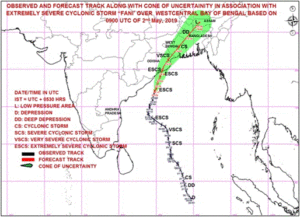
Path of Cyclone Fani. It started as a depression very close to the Equator and moved northwards thereafter. (Photo: IMD)
The IMD had first predicted that Cyclone Fani would make a landfall in Tamil Nadu but the forecast was updated as the cyclone altered its course. Had Cyclone Fani made its landfall in Tamil Nadu, it was possible that its strength would have been lower than its present strength because a landfall in Tamil Nadu would have meant that Fani would have covered a shorter distance over the sea.
Most cyclones that generate exclusively in the Bay of Bengal become relatively weaker by the time they reach the Indian landmass. However, the case with Cyclone Fani is different since it developed almost close to the Equator.
The World Meteorological Organisation (WMO), a United Nations body that monitors weather conditions, had said the extremely severe Cyclone Fani will make landfall in Odisha with wind speeds of more than 170 km/h.
However, even after making the landfall, the cyclone will move north-northeastwards and strike West Bengal as a severe cyclone and is expected to hit Bangladesh on May 4 as a cyclonic storm.
This means that besides having covered a long journey over the sea (during which Cyclone Fani collected a massive amount of moisture), the cyclone will also travel considerable distance over the land.
The timing of Cyclone Fani is important because the cyclone started developing in April, a month that has historically seen very few cyclones that were categorized as extremely severe.
Between 1965 and 2017, India was hit by 145 cyclonic storms that were classified as a severe, very severe, extremely severe and super cyclonic storm. Of these, only seven (5 percent) were in April and 27 (18 percent) in May.
Most of these cyclones (90 i.e. 62 percent) were generated between October and December.
Even after making the landfall, the cyclone will move north-northeastwards and strike West Bengal as a severe cyclone and is expected to hit Bangladesh on May 4 as a cyclonic storm.
Madhavan Rajeevan, secretary in the Ministry of Earth Sciences in a tweet said, “In the past (1891-2017) only 14 severe tropical cyclones were formed in April over the Bay of Bengal and only one storm crossed the Indian mainland. Cyclone Fani is the second storm forming in April and crossing the mainland. The last time it happened was Cyclone Nargis that devastated Myanmar in 2008.”
In the past (1891-2017) only 14 severe tropical cyclones formed in APRIL over Bay of Bengal Only one storm crossed the Indian main land. Cyclone FANI the second storm forming in April and crossing the main land. Last severe cyclone NARGIS in 2008 devastated Myanmar
According to the India Meteorological Department, “Out of 10 recorded cases of very heavy loss of life (ranging from about 40,000 to well over 2,00,000) in the world due to tropical cyclones, nine cases were in the Bay of Bengal and the Arabian Sea.”
Five of these were in Bangladesh, three in India and one in Myanmar.
World’s highest recorded storm tide measuring 45 feet occurred in 1876 during the Bakherganj cyclone near Meghna Estuary, Bangladesh.
In fact, IMD says that the world’s highest recorded storm tide measuring 45 feet occurred in this region. It was way back in 1876 during the Bakherganj cyclone near Meghna Estuary, Bangladesh.
The Indian subcontinent is considered to be one of the worst-affected regions by tropical cyclones. The region has witnessed some of the deadliest cyclones in world history.
According to the Nation Cyclone Risk Mitigation Project (NCRMP), the Indian subcontinent is exposed to “nearly 10 percent” of the world’s tropical cyclones. NCRMP’s data analysis shows that between 1980 and 2000, on an average annually 370 million (37,00,000) people were exposed to cyclones in India.
A 2014 report of the World Meteorological Organisation, a United Nations organization on weather monitoring, states that cyclonic storms have been the main cause of deaths due to natural disasters in Asia between 1970 and 2012. A majority of these cyclone-related deaths have occurred in India and Bangladesh.
When it comes to deaths, cyclonic storms were responsible for 76 percent of all deaths caused by natural disasters in Asia in this period. (The report estimates 9.15 lakh deaths were caused due to natural disasters in Asia and 6.95 of them were related to tropical cyclones.)
The top three deadliest disasters in this period were all tropical cyclones. Two of them hit Bangladesh (in 1970 and 1991) and one hit Myanmar (Cyclone Nargis in 2008). The total deaths caused by just these three cyclones was 5,77,232.
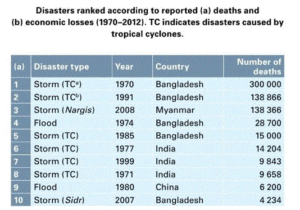
Source: World Meteorological Organisation
Of the 10 most severe natural disasters (in terms of deaths) that struck Asia between 1970 and 2012, eight were tropical storms that hit India, Bangladesh, and Myanmar.
In terms of economic loss, Asia suffered a loss of $789.8 billion in these 42 years and 30 percent of it was due to cyclonic storms.
Taking a global picture, the 10 deadliest disasters that hit the world between 1970 and 2012 included three cyclones in Bangladesh and one in Myanmar.
In fact, the 1970 cyclone in Bangladesh caused the greatest number of deaths (3 lakh) in any natural disaster in the world. The Bangladesh cyclone shared the top place with the 1983 drought in Ethiopia that killed the same number of people.
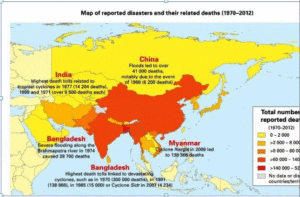
Source: World Meteorological Organisation
Besides this, analysis of the WMO data shows that between 1970 and 2012, 7,77,861 people were killed due to storms (cyclones/hurricanes/tornadoes). However, 89 percent of the deaths (6.95 lakh) were caused in Asia, and primarily in Bangladesh, Myanmar, and India.
How cyclones cause damage?
Cyclones are powerful storms that generate strong windspeeds and have the potential to trigger sudden and heavy rain in the affected areas. There are basically three aspects related to cyclones that have the potential to cause destruction-flooding due to the rising sea, the destruction caused by strong winds and damage due to heavy rains.
Between 1970 and 2012, 7.77 lakh people were killed due to storms cyclones/hurricanes/tornadoes) world over. But, 89% of these deaths (6.95 lakh) were caused in Asia, and primarily in Bangladesh, Myanmar, and India.
When a cyclone is formed over the sea, it generates strong winds along with it. These winds have the potential to generate storm surges. A storm surge is an abnormal rise in the sea level due to a storm (cyclone, hurricane, etc).
A storm surge becomes dangerous because it has the potential to flood low-lying areas along the coast. It can drown humans and animals, destroy infrastructure and damage the environment by eroding beaches, flooding vegetation, among others.
The second dame-causing aspect of cyclones is the strong winds that are generated by the storm. These strong winds that accompany cyclones can uproot trees, electricity poles, shatter houses, etc. This is a common phenomenon in the United States of America which regularly weathers strong hurricanes.
The third aspect with cyclones is their ability to cause sudden, heavy and prolonged rain in the affected areas. This causes floods in rivers, pollutes drinking water and if combined with storm surge, it becomes a double whammy.
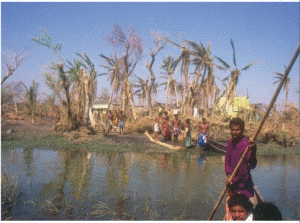
The 1999 cyclone in Odisha (then Orissa) killed more than 9,000 people and was one of the worst disasters in recent Indian history.
Unfortunately, all three factors occur at the same time when a cyclone makes landfall. The IMD states that of three factors, it is a storm surge that is most catastrophic and causes widespread destruction. “Past history indicates that loss of life is significant when surge magnitude is three meters or more and catastrophic when five meters and above,” it says. A possible reason for this could be that not much can actually be done against rising sea waves, especially if they are more than 3 meters in height. Storm surge becomes more dangerous if their timing coincides with the timing of high tides.
East coast of India including Odisha is the more susceptible to tropical cyclones during the onset of monsoon in April and May and retreat of monsoon in the month of October and November respectively. As in each year, littoral states are encountering such natural disasters without any answers, it is for the center and state to get geared up with all sort of preparedness and prepare their financial budgets in advance to mitigate the natural calamity in near future.


